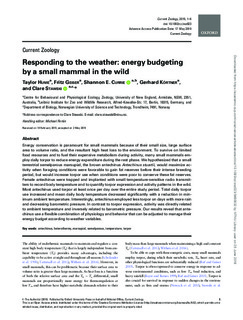| dc.contributor.author | Hume, Taylor | |
| dc.contributor.author | Geiser, Fritz | |
| dc.contributor.author | Currie, Shannon E | |
| dc.contributor.author | Körtner, Gerhard | |
| dc.contributor.author | Stawski, Clare | |
| dc.date.accessioned | 2019-06-26T06:28:52Z | |
| dc.date.available | 2019-06-26T06:28:52Z | |
| dc.date.created | 2019-06-25T12:47:45Z | |
| dc.date.issued | 2019 | |
| dc.identifier.issn | 1674-5507 | |
| dc.identifier.uri | http://hdl.handle.net/11250/2602199 | |
| dc.description.abstract | Energy conservation is paramount for small mammals because of their small size, large surface area to volume ratio, and the resultant high heat loss to the environment. To survive on limited food resources and to fuel their expensive metabolism during activity, many small mammals employ daily torpor to reduce energy expenditure during the rest phase. We hypothesized that a small terrestrial semelparous marsupial, the brown antechinus Antechinus stuartii, would maximize activity when foraging conditions were favorable to gain fat reserves before their intense breeding period, but would increase torpor use when conditions were poor to conserve these fat reserves. Female antechinus were trapped and implanted with small temperature-sensitive radio transmitters to record body temperature and to quantify torpor expression and activity patterns in the wild. Most antechinus used torpor at least once per day over the entire study period. Total daily torpor use increased and mean daily body temperature decreased significantly with a reduction in minimum ambient temperature. Interestingly, antechinus employed less torpor on days with more rain and decreasing barometric pressure. In contrast to torpor expression, activity was directly related to ambient temperature and inversely related to barometric pressure. Our results reveal that antechinus use a flexible combination of physiology and behavior that can be adjusted to manage their energy budget according to weather variables. | nb_NO |
| dc.language.iso | eng | nb_NO |
| dc.publisher | Oxford University Press | nb_NO |
| dc.relation.uri | https://academic.oup.com/cz/advance-article/doi/10.1093/cz/zoz023/5490832 | |
| dc.rights | Navngivelse 4.0 Internasjonal | * |
| dc.rights.uri | http://creativecommons.org/licenses/by/4.0/deed.no | * |
| dc.title | Responding to the weather: energy budgeting by a small mammal in the wild | nb_NO |
| dc.type | Journal article | nb_NO |
| dc.type | Peer reviewed | nb_NO |
| dc.description.version | publishedVersion | nb_NO |
| dc.source.volume | zoz023 | nb_NO |
| dc.source.journal | Current Zoology | nb_NO |
| dc.identifier.doi | doi.org/10.1093/cz/zoz023 | |
| dc.identifier.cristin | 1707550 | |
| dc.description.localcode | © The Author(s) (2019). Published by Oxford University Press on behalf of Editorial Office, Current Zoology. This is an Open Access article distributed under the terms of the Creative Commons Attribution License (http://creativecommons.org/licenses/by/4.0/) | nb_NO |
| cristin.unitcode | 194,66,10,0 | |
| cristin.unitname | Institutt for biologi | |
| cristin.ispublished | true | |
| cristin.fulltext | original | |
| cristin.qualitycode | 1 | |

